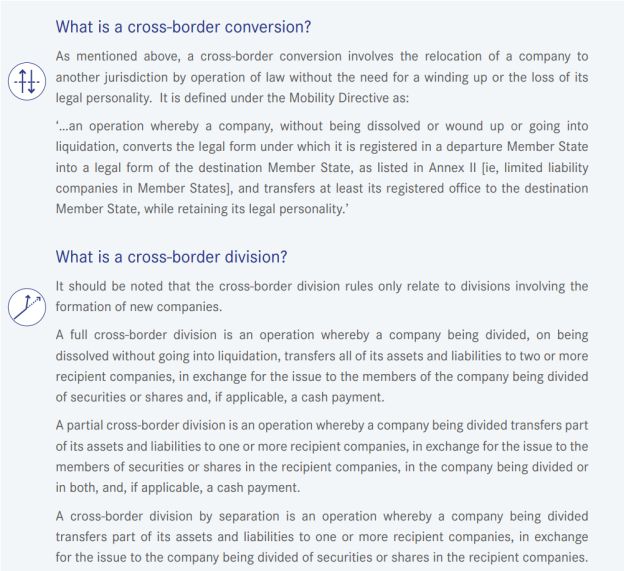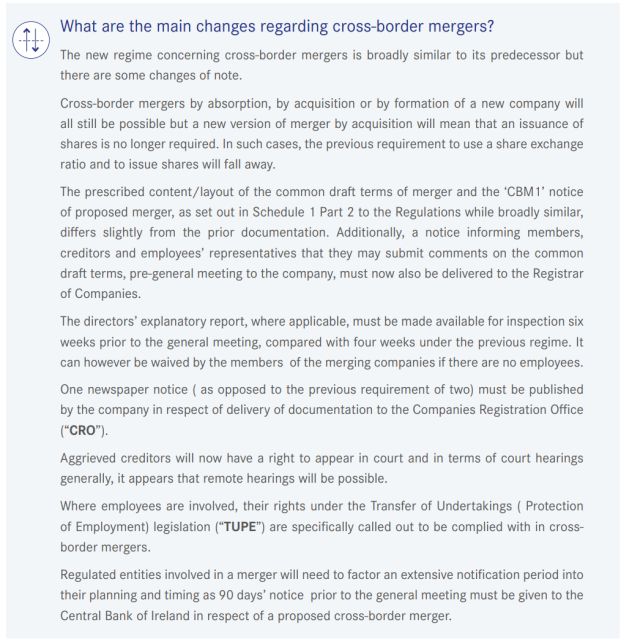- within Corporate/Commercial Law topic(s)
- with readers working within the Accounting & Consultancy and Construction & Engineering industries
- within Compliance, Media, Telecoms, IT, Entertainment and Strategy topic(s)
Key Considerations | At a Glance
In an exciting development for the Irish restructuring landscape, Ireland has at last, transposed the Mobility Directive. In this Article we set out some key considerations as the new regime gets up and running.
What is the full title of the Mobility Directive?
The full title of the Mobility Directive is 'Directive (EU) 2019/2121 of the European Parliament and of the Council of 27 November 2019 amending Directive (EU) 2017/1132 as regards cross-border conversions, mergers and divisions'.
What is the aim of the Mobility Directive?
The overall aim of the Mobility Directive is the elimination of unjustified barriers to the freedom of establishment of EU companies in the single market.
The Mobility Directive enables companies to effectively relocate from one Member State to another Member State by way of (i) conversion, (ii) division, or (iii) merger, while also safeguarding and strengthening the interests of shareholders, creditors and employees. Overall, the Mobility Directive aims to amend the existing EU cross-border merger regime, and to introduce a new EU legal framework for cross-border conversions and divisions (see below for further detail).
Are the Irish transposing regulations in force?
All Member States were required to transpose the Mobility Directive into national law by 31 January 2023. A number of Member States (including Ireland) did not meet this deadline. However, Ireland introduced national transposing legislation on 24 May 2023, pursuant to the European Union (Cross-Border Conversions, Mergers and Divisions) Regulations 2023 (S.I. No. 233 of 2023) (the "Regulations"). For the most part, the Regulations came into effect on the day they were made (24 May 2023).
What are the key matters provided for under the new Mobility Regime?
The Mobility Directive enhances the existing EU cross-border merger regime. It introduces a new legal concept of 'cross-border conversion', whereby it will be possible for an EU limited liability company to relocate to another Member State by operation of law. It also introduces new rules around 'divisions' of limited liability companies, which were previously not provided for under EU legislation. Part 2 of the Regulations deals with cross-border conversions, while Parts 3 and 4 deal with cross-border mergers and cross-border divisions, respectively.
In addition, an important aspect which the Mobility Directive introduces in terms of process, is a rule whereby the relevant competent authorities must scrutinise the legality of a proposed cross-border conversion, merger or division when considering whether to grant a pre-operation certificate (querying whether the process is being carried out for abusive or fraudulent purposes, leading to or aimed at the circumvention of the rights of employees, social security payments or any tax obligations, or for criminal purposes). Should the competent authority suspect abuse or fraudulent practice, it may extend the standard three-month assessment period within which it decides whether or not to grant a certificate, by a further three months.
Protections and safeguards for members, creditors and employees as with the previous cross-border merger regime also apply to operations carried out pursuant to the Mobility Directive.


Does the Mobility Directive only apply in the EU?
Yes, and only to limited liability companies (private and public).
Only a limited liability company formed in accordance with the laws of a Member State and having its registered office, central administration or principal place of business within the EU can avail of the procedures on cross-border mergers, conversions and divisions. In addition, the Mobility Directive expressly excludes a limited liability company in liquidation where the distribution of assets has begun.
Is there a transitional period in relation to cross-border mergers involving Ireland, commenced under the previous legislative regime?
Despite the absence of provisions in the Mobility Directive dealing with transitional arrangements, the Regulations include certain transitional measures which provide that the previous regime shall continue to apply to a cross-border merger where a copy of the common draft terms of merger and / or any required notice(s) were delivered to the Registrar of Companies prior to 24 May 2023. Otherwise, for a proposed cross-border merger where the common draft terms of merger and related notice(s) have not been delivered to the Registrar prior to 24 May 2023, the new regime will apply as set out in the Regulations.
What are the general procedural steps in order to complete a cross-border conversion / merger division?
At a high level, the below are the basic procedural steps which apply in relation to cross-border mergers, conversions, and divisions, as set out in further detail in the Regulations. However, the specific procedural steps will need to be considered and confirmed on a case-by-case basis in relation to a particular transaction, by reference to the Regulations.
- Draft terms of cross-border conversion / merger / division
- Directors' explanatory report for members and employees (covering legal and economic aspects) unless waived. Note: The directors' explanatory report is required to be made available for a period of six weeks, which represents an increase of two weeks when compared to the previous cross-border merger regime. It can however be waived by the members of the merging companies if there are no employees
- An independent expert's report must be prepared (unless waived)
- Publicly file documents with the CRO / company website
- Publication of notice of delivery of documents to the CRO in one national newspaper and in the CRO gazette
- Shareholder approval of the merger / conversion / division ( unless exempted)
- Pre-conversion / merger / division certificate
- Scrutiny of legality by destination Member State
- Registration in destination Member State and recording in departure Member State
Conclusion
The Mobility Directive significantly expands and to some extent simplifies the restructuring options and tools available to Irish companies. The introduction of the Regulations is a welcome development from an Irish perspective further enhancing the corporate structuring landscape. However, the smooth operation of the new regime will be dependent on both the departing and destination Member States having transposed the Mobility Directive and having systems in place to facilitate and support it.
While there might be some bumps along the way initially, the future looks bright!
The content of this article is intended to provide a general guide to the subject matter. Specialist advice should be sought about your specific circumstances.




